Manga art combines distinctive character designs with dynamic storytelling techniques. Artists focus on expressive eyes, unique hairstyles, and emotional facial features to bring characters to life. Dynamic action poses, speed lines, and impact frames create energy on the page, while authentic Japanese settings enhance cultural depth. From adorable chibis to magical girls and intriguing villains, manga offers endless creative possibilities. These fifteen ideas will reveal the secrets to creating enchanting Japanese-style characters that leap off the page.
Key Takeaways
- Create expressive manga characters with distinctive eyes, hairstyles, and facial features that convey personality traits and emotions.
- Develop chibi-style characters with exaggerated head-to-body proportions (2:1 or 3:1) to achieve an adorable appearance.
- Incorporate dynamic action poses with gesture drawing, foreshortening techniques, and action lines to increase visual energy.
- Design authentic Japanese settings featuring traditional architecture, seasonal elements, and cultural touchpoints like festivals.
- Illustrate character transformations through evolving hairstyles, posture changes, and facial expressions that reflect emotional growth.
Essential Facial Features for Expressive Manga Characters
When creating enchanting manga characters, mastering facial features is absolutely essential! The eyes are the star of the show, ranging from huge sparkly orbs to narrow slits that reveal a character’s innermost feelings.
Artists can play with eyebrow shapes too—angled for anger, raised for surprise, or curved for worry—to instantly communicate emotions that jump off the page.
Eyebrows are emotional powerhouses in manga—angled, raised, or curved to make feelings leap visually from every panel.
Don’t forget the mouth! Though often simple, its shape speaks volumes: a tiny “u” shape shows sadness, while a wide grin broadcasts joy.
Hair completes the package, with wild spikes or sleek styles helping define personality traits.
The magic of manga lies in these essential facial features for expressive manga characters. By practicing different combinations on outline sheets, young artists can create characters whose emotions are crystal clear!
Creating Dynamic Action Poses in Your Manga Artwork
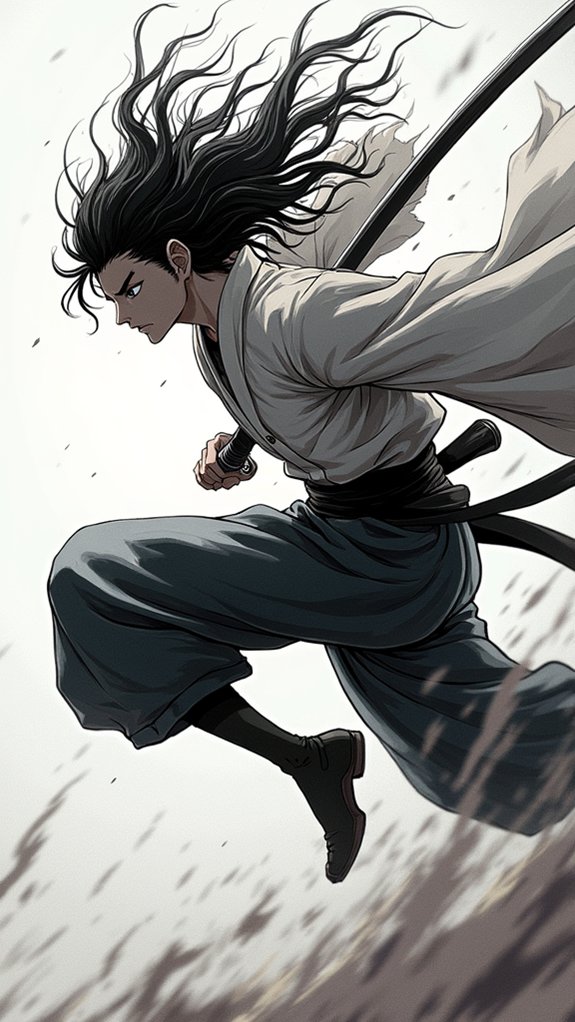
Beyond mastering facial expressions, manga artists need to breathe life into their characters through movement! Creating dynamic poses starts with understanding human anatomy and studying reference images to capture realistic proportions even during wild action sequences.
Action lines and exaggerated body angles are a manga artist’s secret weapons! These techniques enhance the energy of a scene, making readers feel the excitement jumping off the page.
Try practicing gesture drawing—quick sketches that capture the essence of a pose without getting bogged down in details. Remember to play with perspective too! Foreshortening makes limbs appear to reach toward the reader, creating depth and dimension.
Don’t forget that body language and facial expressions work together during action scenes to tell stories that words alone never could!
Designing Distinctive Manga Character Hairstyles
Hair might be the most iconic element of manga character design! When designing distinctive manga character hairstyles, artists consider how these visual features reflect personality traits and emotions.
Spiky, wild locks can suggest energy and rebellion, while smooth, flowing styles often indicate calmness or elegance. Color choices matter too—bright blues or pinks express liveliness, while darker shades might reveal a mysterious nature.
- Try adding unique accessories like hair clips, ribbons, or even animal ears to make your character stand out.
- Use reference images to practice drawing different hair textures, from silky straight to bouncy curls.
- Consider your character’s background and personality when choosing their hairstyle—a warrior might have practical hair, while a magical character could have gravity-defying locks.
- Experiment with shading techniques to give hair volume and dimension.
Mastering Chibi-Style Character Proportions

Creating adorable chibi characters starts with understanding their unique proportions, where the head takes up a third of the total body height and those big, expressive eyes dominate half the face.
Artists can quickly master the chibi look by keeping the body-to-head ratio at 2:1 or 3:1, giving characters that instantly recognizable cute, stubby appearance that manga fans love.
The secret to bringing these mini-figures to life lies in their facial features—exaggerated eyes, tiny noses, and simple mouths that can show a whole range of emotions with just a few well-placed lines!
Simple Proportions Guide
The magic of chibi-style manga characters lies in their delightful, exaggerated proportions that instantly capture hearts. This simple proportions guide makes creating these adorable figures accessible to artists of all skill levels.
The classic 2:1 head-to-body ratio forms the foundation of chibi design, emphasizing cuteness through those iconic oversized heads that make up about one-third of the character’s total height.
- Start with a large circle for the head and add a much smaller body below
- Draw simplified facial features—big expressive eyes and tiny mouths work wonders!
- Keep limbs short and stubby for maximum cuteness factor
- Allow slight proportion adjustments for dynamic poses while maintaining the big-headed look
Mastering these basics gives artists a fun framework to develop their unique chibi style!
Body-to-Head Ratio Tricks
Now that you’ve got those basic chibi proportions down, let’s reveal the secret magic behind those adorably oversized heads!
The key to perfect chibi characters lies in their body-to-head ratio tricks. Most artists use a ratio between 1:2 and 1:4, meaning the head is twice to four times larger than the body height.
Start with a big circle for the head, then add a tiny body that’s only 1-2 head heights tall. Keep those limbs super short and rounded – like little sausages attached to the body!
This creates that squishable, ultra-cute vibe that makes chibis so lovable. For extra practice, try using chibi outline sheets to get the proportions just right.
These tricks will help your characters look playful and dynamic while maintaining that perfect balance of cute and quirky!
Expressive Facial Features
When it comes to creating truly adorable chibi characters, expressive facial features steal the spotlight! These exaggerated elements bring personality to life through oversized eyes, varied mouth shapes, and simple emotional cues.
In chibi art, the face becomes a canvas for emotion, where even minimal details speak volumes.
- Large, round eyes (about 1/4 of the face) can shift from sparkling happiness to teary sadness with just a few strokes.
- Mouth designs range from tiny “v” shapes for contentment to exaggerated “O” shapes for surprise or excitement.
- Eyebrows play a huge role—thin arches show surprise while thick, angled brows scream anger.
- Blush marks (small circles or lines on cheeks) instantly add cuteness or embarrassment.
Mastering these expressive features allows artists to create chibi characters that communicate feelings powerfully, despite their tiny size!
Emotional Storytelling Through Eye Variations
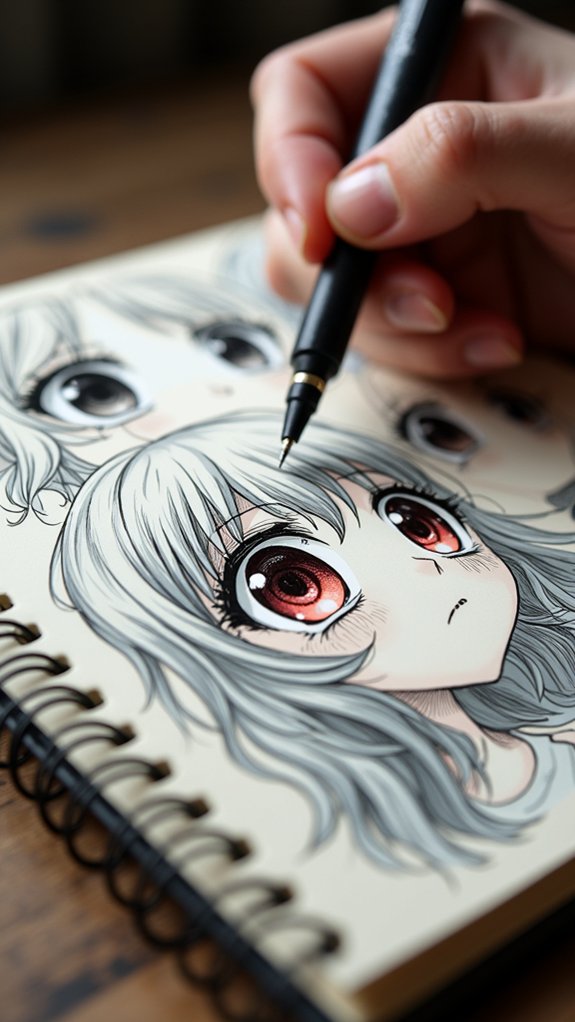
In manga art, the eyes serve as powerful windows into a character’s soul, displaying their emotions, intentions, and hidden depths with subtle variations.
Artists can transform a character’s entire mood by adjusting eye shapes, adding sparkles for joy, teardrops for sorrow, or narrowed lines for suspicion.
Mastering these emotional eye variations gives manga creators a secret language to connect with readers, making characters jump off the page and tug at our heartstrings without saying a single word.
Manga Eyes Speak Volumes
The eyes truly serve as windows to the soul in manga artistry, revealing characters’ innermost feelings without a single word spoken.
When manga eyes speak volumes, artists rely on subtle variations to convey complex emotions that drive storytelling forward. The distinct shapes, sizes, and details transform simple drawings into characters bursting with personality.
- Sharp, narrowed eyes with angular eyebrows instantly communicate anger or determination
- Large, sparkling eyes with light reflections show wonder, joy, or admiration
- Downturned eyes with heavy shading beneath capture sadness or despair
- Trembling irises with exaggerated teardrops create dramatic crying scenes that pull at the reader’s heartstrings
Mastering Emotional Depth
Passion radiates through carefully crafted manga eyes, transforming simple drawings into characters readers can’t help but connect with. The magic happens in the details—large, round eyes convey innocence while sharp, narrow ones signal danger or determination.
When characters get fired up, artists use angular shapes, furrowed brows, and dramatic highlights to show their anger jumping off the page!
Crying scenes rely on teary glimmers and downturned eye shapes, often paired with blush marks for maximum emotional resonance.
Want to level up your manga art? Experiment with different eye designs for each character’s personality.
Grab some practice sheets focusing on expressions, and watch how changing just the eyes can tell an entire story! Your characters will practically speak to readers without saying a single word.
Drawing Authentic Japanese School Uniforms for Characters
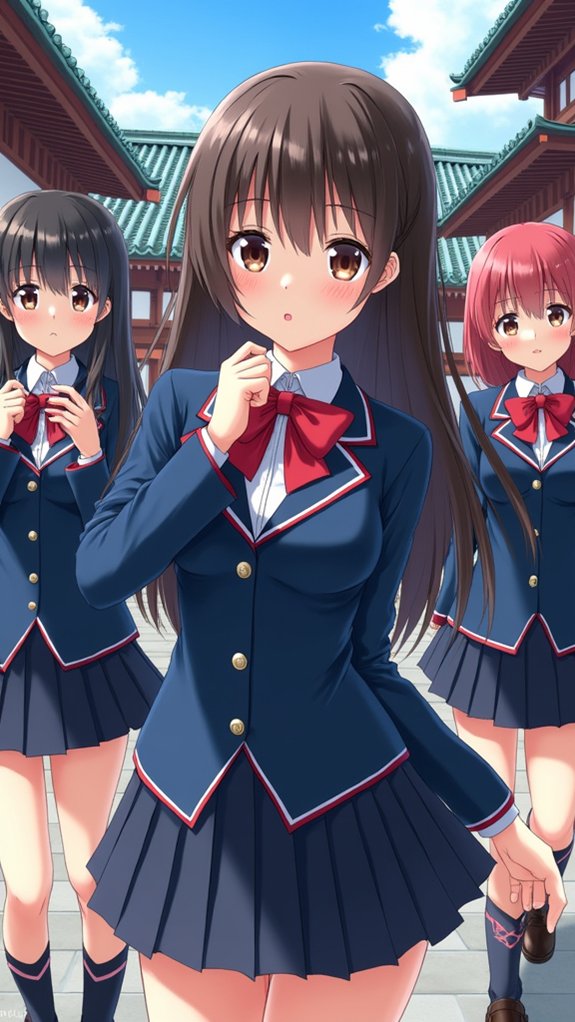
When creating authentic manga characters, accurately depicting Japanese school uniforms can instantly transport readers to the hallways of a Japanese school.
These iconic “seifuku” are an essential element of Japanese art and storytelling, carrying cultural significance and school pride. Artists should pay special attention to the distinct styles—sailor suits for girls with their pleated skirts and neckties, and the structured jackets with high collars for boys.
Authentic seifuku designs capture Japanese school identity through distinctive sailor collars, pleats, and structured gakuran that speak volumes beyond mere uniform.
- Nail those tiny details like school emblems, button placements, and fabric folds that make uniforms look realistic.
- Master the pleats in girls’ skirts—they’re super tricky but totally worth it!
- Don’t forget seasonal variations like cardigans for winter or rolled-up sleeves for summer.
- Include accessories like school bags, indoor shoes, and personal touches that show character personality.
Crafting Compelling Manga Villains and Anti-Heroes
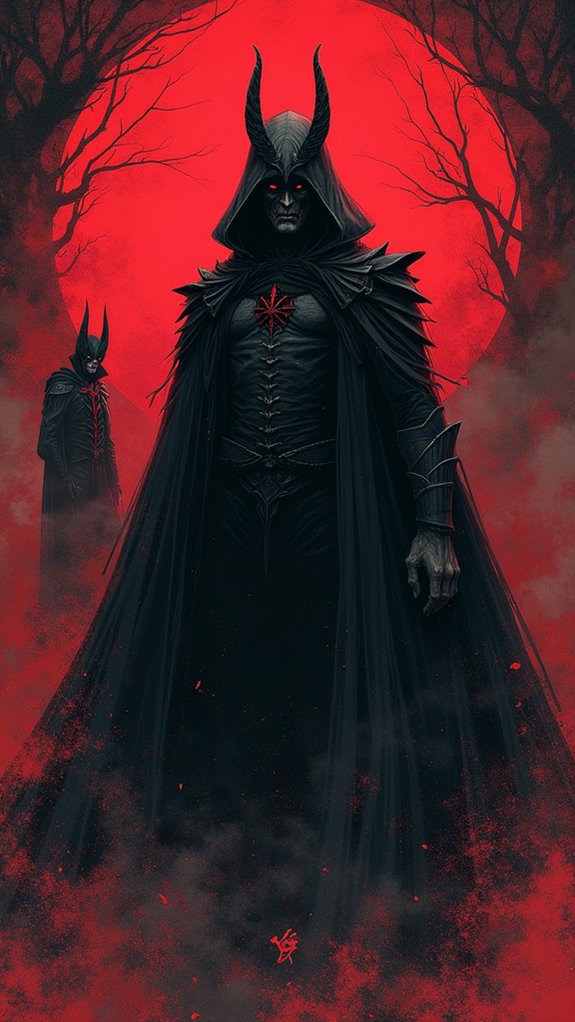
Crafting unforgettable manga villains and anti-heroes requires artists to balance menacing design elements with hints of humanity that make readers question their own moral compass.
Great antagonists need convincing motives and rich backstories that explain (but don’t excuse) their evil deeds, transforming them from cardboard cutouts into characters readers secretly root for.
Anti-heroes shine when their visual design reflects their inner conflict—try mixing traditionally heroic and villainous traits, like a character with kind eyes but sinister clothing, to signal their complex moral standing.
Creating Memorable Villains
Great manga villains stand at the heart of unforgettable stories, drawing readers in with their complexity and depth. The most memorable manga villains aren’t simply evil—they have reasons for their actions that readers can understand, even if they don’t agree.
Their visual design, from unique facial features to distinctive clothing, becomes instantly recognizable and often reflects their inner turmoil.
- Give your villain a backstory that explains why they believe they’re the hero of their own story
- Design their appearance with signature colors or visual elements that hint at their personality
- Show their emotions through expressive eyes that reveal glimpses of vulnerability or determination
- Create moments where they challenge the hero’s beliefs, forcing both characters to grow
Motivation and Backstory
Behind every great villain lies a story waiting to be told. The most compelling manga antagonists aren’t simply evil – they’re shaped by past traumas, dreams, and disappointments that fuel their actions.
When crafting different manga style characters, especially villains and anti-heroes, their motivation and backstory become the foundations that make readers secretly root for them!
Think about Orochimaru’s quest for immortality born from fear of death, or Light Yagami’s twisted sense of justice. These characters work because we comprehend why they do terrible things, even if we don’t agree with them.
The best villains make us wonder, “Would I have turned out differently in their shoes?” By giving antagonists relatable motivations – lost loved ones, betrayal, or societal rejection – artists create characters who linger in readers’ minds long after the story ends.
Anti-Hero Design Elements
Visual power lies at the heart of every memorable manga anti-hero. When artists design these complex characters, they blend distinctive visual elements with hints of their troubled past.
Anti-heroes in manga stand out through their unconventional appearances that mirror their internal struggles, making them instantly recognizable and deeply fascinating to readers.
- Asymmetrical hairstyles or clothing that reflect the character’s unbalanced moral compass
- Expressive eyes that convey both vulnerability and determination
- Dramatic poses showing both strength and inner conflict
- Scars or other physical markings that hint at past trauma
These design elements don’t just look cool—they tell a story! By carefully crafting visual cues that reveal character depth, manga artists create anti-heroes who are both visually striking and emotionally compelling, drawing readers into their complicated worlds.
Illustrating Fantasy Elements in Shōnen Manga Style
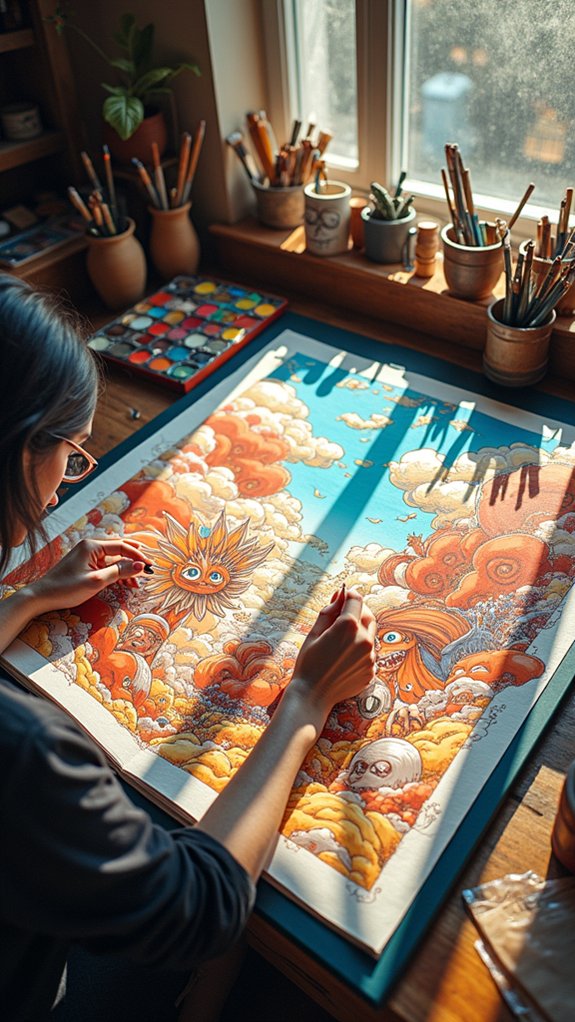
When artists breathe life into fantasy worlds through shōnen manga, they release unlimited creative possibilities that captivate readers of all ages. The most successful manga artists blend supernatural abilities, mythical creatures, and alternate dimensions into their storytelling, creating worlds where anything seems possible.
These fantasy elements serve as perfect backdrops for epic battles and character growth. Action scenes pop with dynamic energy—characters leaping impossibly high or releasing magical attacks with dramatic flair. Artists use exaggerated perspectives and motion lines to make these moments feel explosive and thrilling.
Character designs feature distinctive traits like spiky blue hair, magical weapons, or transformation abilities that instantly communicate personality. Through training arcs, magical artifacts, and fierce rivalries, artists create visual journeys that showcase the heart of shōnen manga—friendship and determination conquering all obstacles.
Background Techniques to Enhance Your Manga Scenes
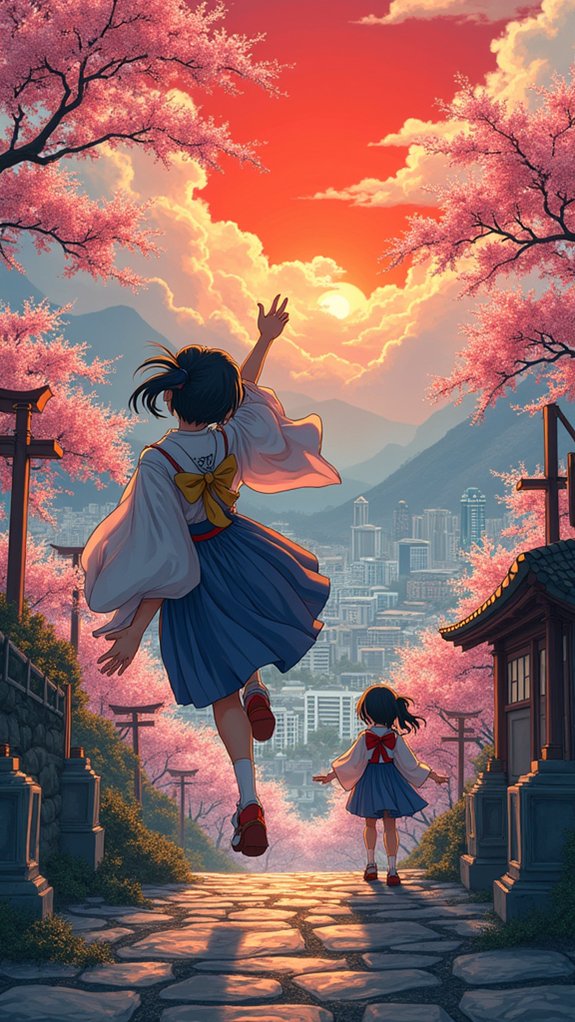
The difference between amateur and professional manga lies largely in how artists craft their backgrounds. Beautifully illustrated scenes don’t just happen by accident—they require specific background techniques to enhance your manga scenes.
Artists can transform flat pages into dynamic worlds by experimenting with perspective, texture, and layering to create depth that pulls readers into the story.
- Try gradients with colored pencils or digital tools to add dimension to skies and settings
- Use perspective drawing for cool angles that make buildings and streets look real
- Mix up your brush techniques for natural elements—splatter effects make awesome stars and rain!
- Add patterns and textures to backgrounds using mixed media like watercolor washes
Speech Bubble Styles and Text Integration for Manga Pages
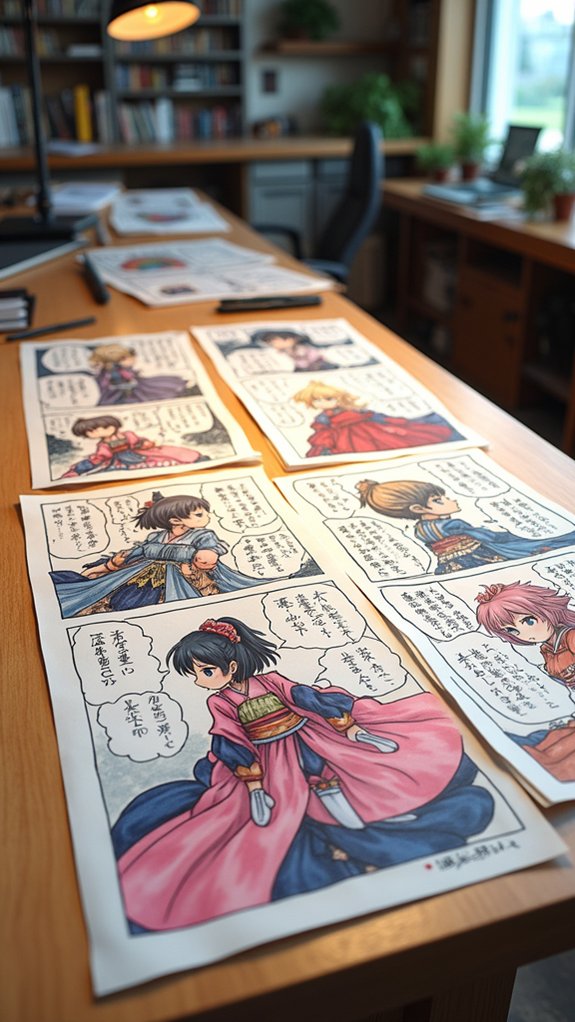
Speech bubbles and text might seem like small details, but they’re actually powerful storytelling tools that breathe life into manga characters! The shape of a bubble instantly tells readers about the emotion behind the words—jagged edges for shouting, cloud-like bubbles for thoughts, and neat circles for normal speech.
| Bubble Type | Emotion | Best Used For |
|---|---|---|
| Jagged | Anger/Shock | Arguments, surprises |
| Cloud-like | Dreamy/Thoughts | Inner monologues |
| Rectangular | Narration | Scene changes |
Placement matters too! Bubbles should guide your reader’s eye across the page in the right order. Keep your text style consistent throughout your manga—this creates a visual language readers can easily follow. Don’t forget those awesome sound effects! When drawn right into the artwork, “BOOM!” and “SWOOSH!” make action scenes jump off the page!
Character Development Through Visual Transformation
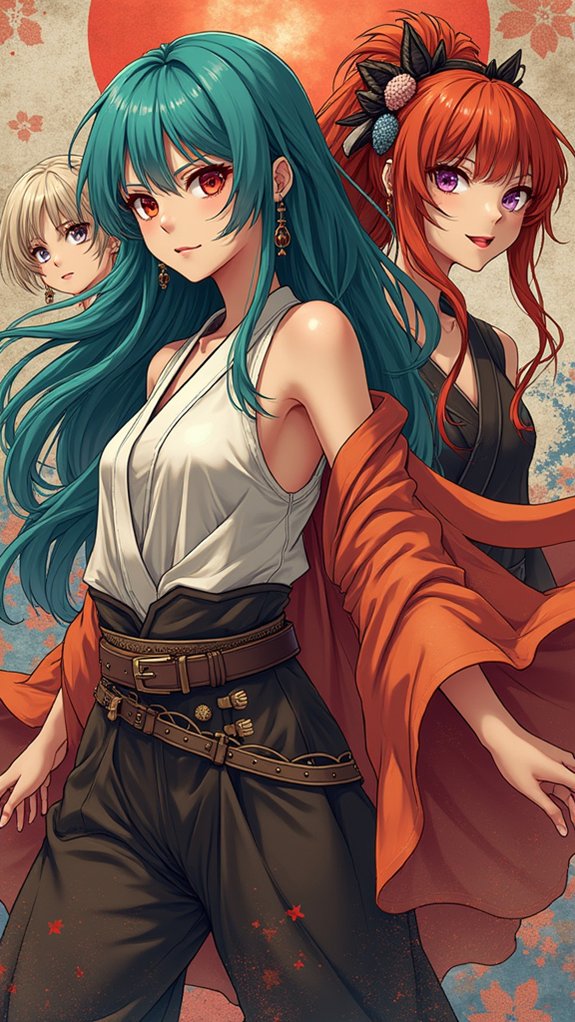
Character growth in manga happens through subtle visual changes that tell a powerful story without words.
Artists use distinctive facial expressions—from wide-eyed shock to furrowed-brow determination—to show how characters react to challenges and grow stronger with each obstacle.
These visual transformations, combined with evolving hairstyles, clothing, and posture, create a visual timeline of the character’s journey that readers can follow from page one to the dramatic finale.
Emotions Through Expressions
Emotions burst forth from the page when manga artists master the art of expressive character design. The Japanese illustration style relies heavily on emotions through expressions, with characters showing feelings in ways that instantly connect with readers.
Artists manipulate facial features to create emotional moments that drive storytelling forward, turning simple drawings into characters readers care about.
- Wide, sparkling eyes show excitement and joy, while narrowed eyes with darkened pupils convey anger or determination.
- Different mouth shapes – from toothy grins to wobbling frowns – instantly telegraph a character’s mood.
- Sweat drops, blush marks, and steam effects amplify emotional states beyond what faces alone can show.
- Color changes in eyes or backgrounds emphasize emotional shifts during important story moments.
Character Arc Visualization
Transformation lies at the heart of compelling manga storytelling, where artists bring character growth to life through deliberate visual changes. Character arc visualization helps readers connect with a protagonist’s journey on a deeper level, making emotional changes tangible through art!
Series of sketches can track these transformations—a shy character might start with hunched shoulders and downcast eyes, gradually standing taller as their confidence blooms.
Colors tell powerful stories too! A hero’s palette might shift from gloomy blues to vibrant reds as they discover their inner strength.
Even clothing evolves with the character—tattered, plain outfits becoming more distinctive as the person inside finds their true self.
Using emotion outline sheets, artists can map these changes systematically, ensuring each expression perfectly captures that moment in their epic journey!
Drawing Authentic Japanese Settings for Manga Stories

Creating authentic Japanese settings stands at the heart of compelling manga storytelling, bringing stories to life with visual details that transport readers directly to Japan. Artists who master drawing authentic Japanese settings for manga stories capture both the historical charm and modern energy that makes Japan unique.
- Traditional Japanese architecture like curved pagoda roofs, sliding paper doors, and peaceful tea houses creates instantly recognizable backdrops.
- Seasonal elements such as cherry blossoms in spring or snow-capped Mount Fuji add emotional depth to scenes.
- Urban environments featuring neon-lit Tokyo streets contrast beautifully with quiet countryside rice fields.
- Cultural touchpoints like summer festivals with lanterns, shrine gates, and traditional marketplaces help readers feel immersed in Japanese daily life.
Creating Magical Girl Characters in the Mahō Shōjo Tradition
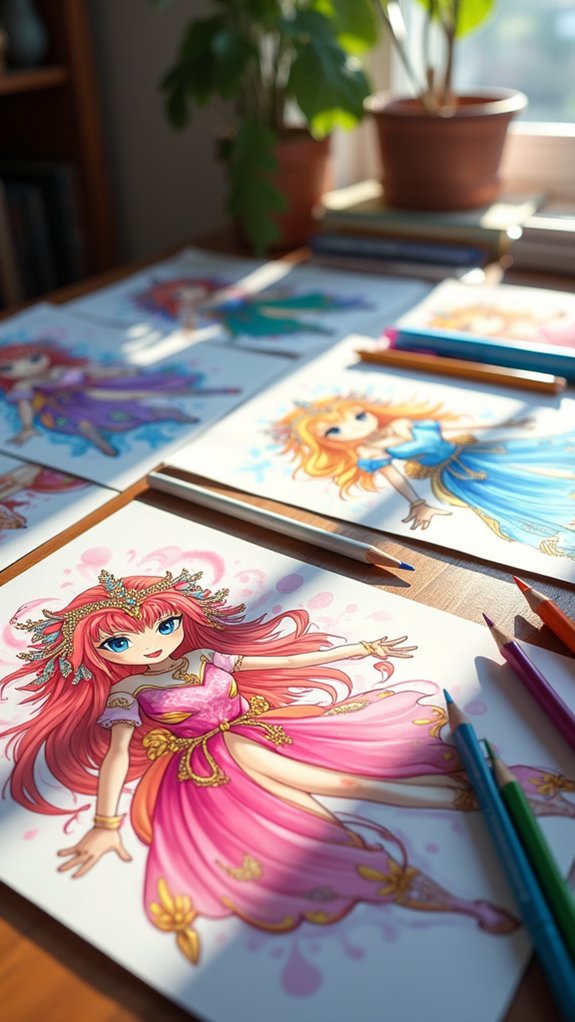
The bright, magical world of Mahō Shōjo manga captivates artists and readers alike with its blend of adventure, friendship, and dazzling transformations. Creating a compelling magical girl character requires thoughtful design choices that balance cuteness with power.
| Design Element | Purpose | Example Ideas |
|---|---|---|
| Transformation Item | Triggers magical powers | Wand, brooch, compact |
| Signature Color | Reflects personality | Pink (loving), Blue (calm) |
| Magical Weapon | Battles evil forces | Staff, bow, magical cards |
| Animal Companion | Provides guidance | Cat, rabbit, fairy creature |
| Costume Motif | Shows magical specialty | Stars, flowers, elements |
When sketching your magical girl character, focus on expressive eyes and dynamic poses that capture both vulnerability and strength. Remember, the best designs combine familiar genre elements with your unique artistic twist!
Manga Panel Layout Strategies for Visual Storytelling
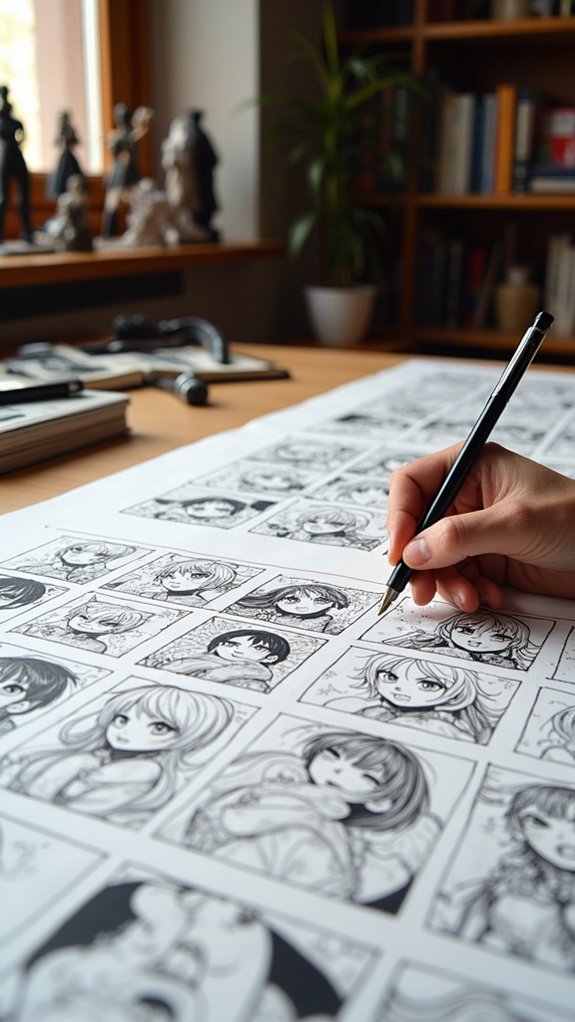
Masterful manga storytelling relies heavily on panel layout, the invisible architecture that guides readers through each page’s emotional journey. Artists strategically organize panels to create rhythm, emphasis, and flow, much like a director frames scenes in a movie.
Effective panel layout strategies transform static images into dynamic narratives that pull readers through the story without confusion.
- Vary panel sizes dramatically—tiny panels for quick actions, sprawling ones for breathtaking moments
- Break panel borders when characters experience intense emotions, literally “breaking free” of constraints
- Create diagonal flows across the page to increase tension during action sequences
- Layer overlapping panels to show simultaneous actions or closely related moments in time
The rule of thirds helps place focal points exactly where readers’ eyes naturally land, making even complex layouts feel intuitive and exciting!
Capturing Movement With Speed Lines and Impact Frames
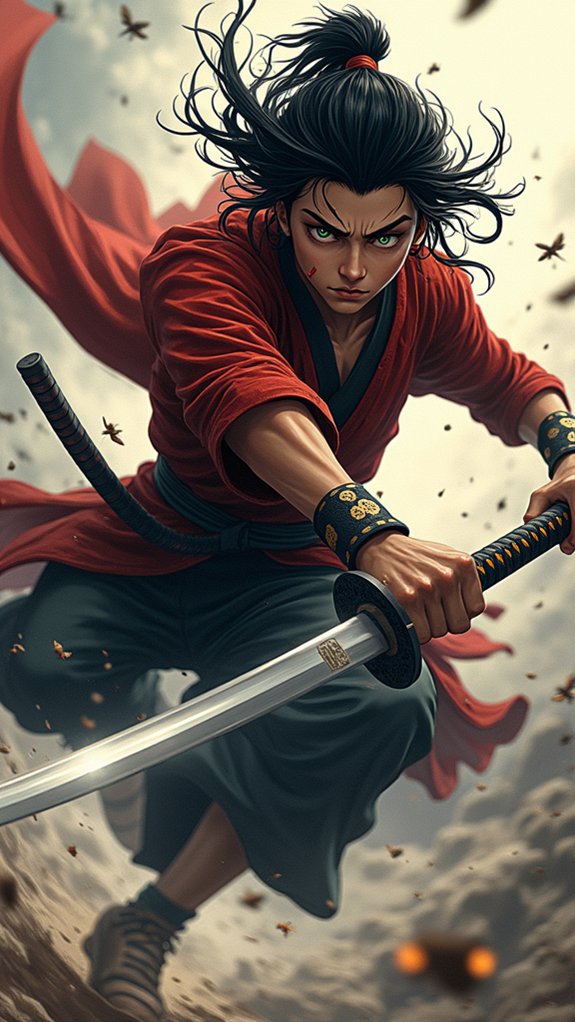
While effective panel design builds the backbone of manga storytelling, dynamic movement brings those panels to life. Speed lines are the manga artist’s secret weapon for showing motion, radiating from characters to create a sense of urgency. The longer and thicker these lines, the faster the movement appears!
Impact frames take action to the next level, highlighting those jaw-dropping moments when a hero lands a killer punch or a villain releases their power. These bold, exaggerated panels make readers feel like they’re right in the middle of the action!
For extra dynamic scenes, artists combine speed lines with motion blur, making characters practically zoom off the page. This technique doesn’t just show cool moves—it controls the story’s pace, telling readers exactly where to focus their attention.
Frequently Asked Questions
How to Design a Character for a Manga?
Effective manga character design requires developing unique character concepts through distinctive visual traits, emotional depth, and backstory that resonates with readers while supporting the narrative’s thematic elements.
How to Find My Manga Art Style?
Finding one’s manga art style requires dedicated Art Exploration. Artists should experiment with different techniques, study diverse creators, practice consistently, and seek constructive feedback to discover their unique artistic voice.
Is Manga a Japanese Art Style?
Yes, manga is a Japanese art style with distinct cultural origins in Japan’s artistic traditions. Its unique visual language and storytelling conventions developed specifically within Japanese cultural context.
How to Draw Good Manga Characters?
Drawing compelling manga characters requires mastering proportional anatomy, perfecting Character Expressions, using reference sheets, developing distinct visual traits, and practicing consistent styles through regular sketching and observation.
Conclusion
Manga art offers endless creative possibilities for young artists enthusiastic to tell their own Japanese-style stories. By mastering expressive faces, dynamic poses, and distinctive character designs, anyone can bring their imagination to life on paper. Whether you’re drawing epic battles with speed lines or cute chibis with oversized heads, these techniques will help transform your drawings from simple sketches into enthralling visual narratives that leap off the page. Grab your pencil and start creating!


Leave a Reply